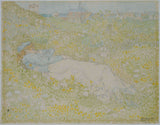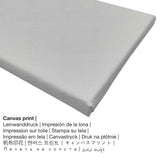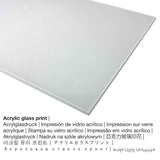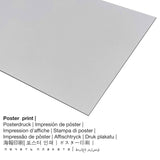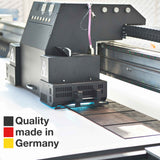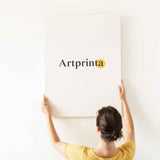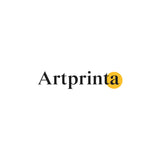Jan Toorop, 1902 - Nwanyị dina na dunes dị nso na Noordwijk - ọmarịcha nka.
Ụtụ gụnyere. Mbupu gbakọrọ na ndenye ọpụpụ.
Ihe osise a karịrị afọ 110 Woman Lying in the Dunes near Noordwijk was created by Jan Toorop. What is more, this piece of art forms part of the digital art collection of Rijksmuseum, nke bụ nnukwu ihe ngosi nka maka nka na akụkọ Dutch site na Middle Ages ruo ugbu a. Nke a nkà nke oge a masterpiece, nke bụ akụkụ nke ọha ngalaba na-nyere na site n'ikike nke Rijksmuseum.Kridi n'obi nke artpiece bụ ndị a: . Ọzọkwa, alignment bụ odida obodo ya na oke onyonyo nke 4: 3, nke pụtara na ogologo bụ 33% ogologo karịa obosara. The artist, painter, graphic artist, postage stamp designer Jan Toorop was a European artist from the Netherlands, whose style can primarily be classified as Symbolism. The European artist was born in 1858 na Purworejo, Jawa Tengah, Indonesia wee nwụọ mgbe ọ dị afọ 70 na 1928.
Nkọwa agbakwunyere dị ka enyere ya Rijksmuseum (© - site na Rijksmuseum - Rijksmuseum)
Toorop and his wife, Annie Hall, lived in Katwijk aan Zee between 1899 and 1904. His good friend, the poet Albert Verwey, lived in nearby Noordwijk. This drawing must have originated on one of his walks through the dunes to Verwey’s house. It is not known who the woman is. In the background is the seaside resort of Noordwijk aan Zee, with the Huis ter Duin hotel at the left.
Nkọwa nka ahaziri
| Aha nka nka: | "Woman Lying in the Dunes near Noordwijk" |
| Nhazi nka: | sere |
| Otu izugbe: | nkà nke oge a |
| Narị afọ nka: | 20th narị afọ |
| Year: | 1902 |
| Afọ nka: | karịa afọ 110 |
| Ụlọ ihe ngosi nka / mkpokọta: | Rijksmuseum |
| Ebe ebe ngosi nka: | Amsterdam, Netherlands |
| URL webụ: | Rijksmuseum |
| Ụdị ikike nka: | ngalaba ọha |
| Site n'aka: | Rijksmuseum |
Nchịkọta dị mkpirikpi nke onye na-ese ihe
| Aha onye nka: | Jan Toorop |
| A makwaara dịka: | Toorop Jan Theodoor, Johannes Theodorus Toorop, Jan Toorop, Toorop Jean Theodoor, Jean Theodoor Toorop, Jan Theodoor Toorop, Toorop Jean Theodoro, טורופ יאן, Toorop Jan |
| Gender: | nwoke |
| Obodo onye nka: | Dutch |
| Ọrụ onye na-ese ihe: | graphic artist, postage stamp designer, artist, painter |
| Obodo obibi: | mba netherland |
| nhazi ọkwa: | omenkà nke oge a |
| Ụdị nka: | Akara |
| Nwụrụ anwụ: | 70 afọ |
| Afọ ọmụmụ: | 1858 |
| Amụrụ na (ebe): | Purworejo, Jawa Tengah, Indonesia |
| Nwuru: | 1928 |
| Nwụrụ na (ebe): | Hague, The, South Holland, Netherlands |
Kedu nke ga-abụ nhọrọ akụrụngwa kacha amasị gị?
Anyị na-enye ụdị dị iche iche nha na ihe maka ngwaahịa ọ bụla. Họrọ n'ime nhọrọ ngwaahịa ndị a ugbu a ka ị kwekọọ na mmasị gị na nha na akụrụngwa:
- Glass acrylic ebipụtara nwere mmetụta na-egbuke egbuke: An acrylic glass print, often described as a print on plexiglass, will change the original work of art into lovely décor. The work of art will be printed with the help of state-of-the-art UV printing technology.
- Metal (aluminium debond mbipụta): An Aluminium Dibond print is a material with an outstanding depth. A direct Aluminium Dibond Print is the perfect start to replicas with alu. For your Direct Aluminium Dibond option, we print your favorite work of art right onto the aluminium surface. The bright parts of the original artwork shimmer with a silk gloss but without any glow. The UV print on aluminium is the most popular entry-level product and is a truly stylish way to showcase art reproductions, since it puts 100% of the viewer’s attention on the artwork.
- Mpempe akwụkwọ ederede (akwa akwa akwa): Our poster is a printed sheet of canvas paper with a slightly rough finish on the surface. It is suited for putting your art copy with a special frame. Please keep in mind, that depending on the absolute size of the poster we add a white margin between 2-6cm around the print, which facilitates the framing with your custom frame.
- Kwaaji: The printed canvas stretched on a wood frame. How do I hang a canvas on the wall? The great advantage of canvas prints is that they are relatively low in weight. This means, it is quite simple to hang up your Canvas print without any wall-mounts. Because of thata canvas print is suitable for any kind of wall.
Banyere ihe a
| Bipụta ngwaahịa: | ọmarịcha nka |
| Mmeputakwa: | dijitalụ mmeputakwa |
| Usoro mmepụta: | Mbipụta UV ozugbo |
| Production: | German mmepụta |
| Ụdị ngwaahịa: | mmepụta ihe na-achọ |
| Ojiji ngwaahịa: | ihe ndozi mgbidi, ihe ndozi ụlọ |
| Nhazi nka nka: | usoro odida obodo |
| Oke akụkụ onyonyo: | 4: 3 |
| Nkọwa nke oke akụkụ: | ogologo bụ 33% ogologo karịa obosara |
| Ụdị ngwaahịa dị iche iche: | Mbipụta kwaaji, mbipụta enyo acrylic (nwere ezigbo mkpuchi iko), mbipụta ọla (aluminium dibond), mbipụta akwụkwọ mmado (akwụkwọ kwaaji) |
| Ọdịiche dị n'okirikiri akwa akwa akwa (akwa akwa): | 40x30cm - 16x12", 80x60cm - 31x24", 120x90cm - 47x35", 160x120cm - 63x47" |
| Mpempe iko acrylic (nwere ezigbo mkpuchi iko) nha: | 40x30cm - 16x12", 80x60cm - 31x24", 120x90cm - 47x35", 160x120cm - 63x47" |
| Ụdị akwụkwọ mmado (akwụkwọ kwaaji) dị iche iche: | 40x30cm - 16x12", 80x60cm - 31x24", 120x90cm - 47x35" |
| Mpempe akwụkwọ Dibony (ihe alumnium) nha dị iche iche: | 40x30cm - 16x12", 80x60cm - 31x24", 120x90cm - 47x35" |
| Igwe onyonyo: | na-enweghị etiti |
Ederede iwu dị mkpa: We try whatever we can to depict the art products as exact as possible and to illustrate them visually in our shop. At the same time, the colors of the printing material and the print result might diverge marginally from the representation on your device's monitor. Depending on the screen settings and the condition of the surface, not all color pigments can be printed 100% realistically. Since all the art prints are printed and processed by hand, there might as well be slight deviations in the exact position and the size of the motif.
© nwebiisinka | www.artprinta.com (Artprinta)

